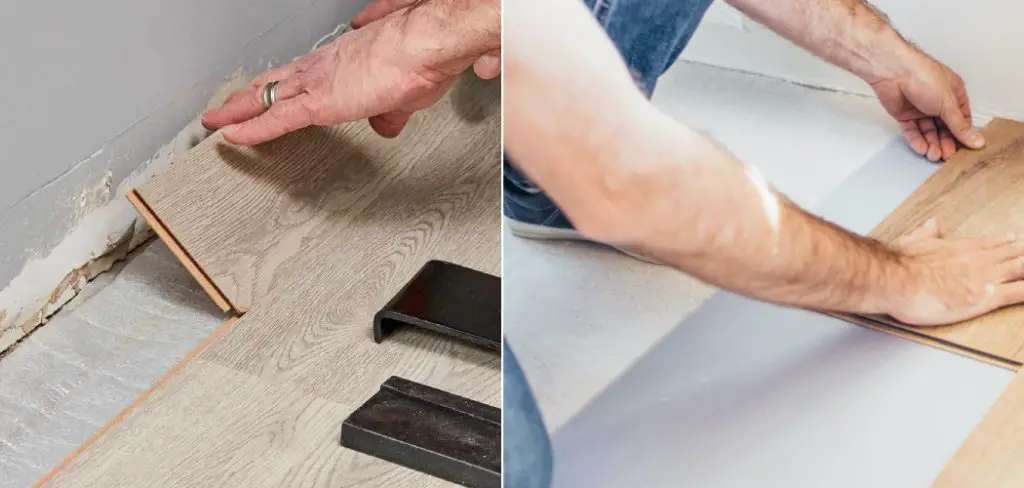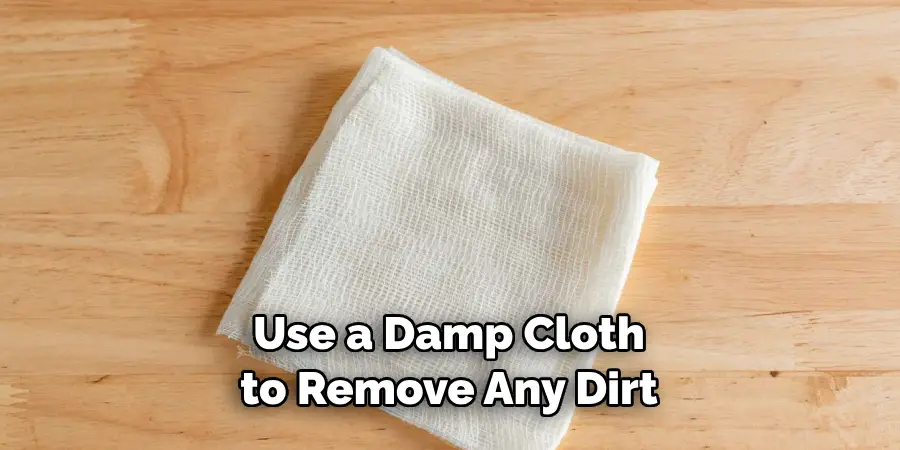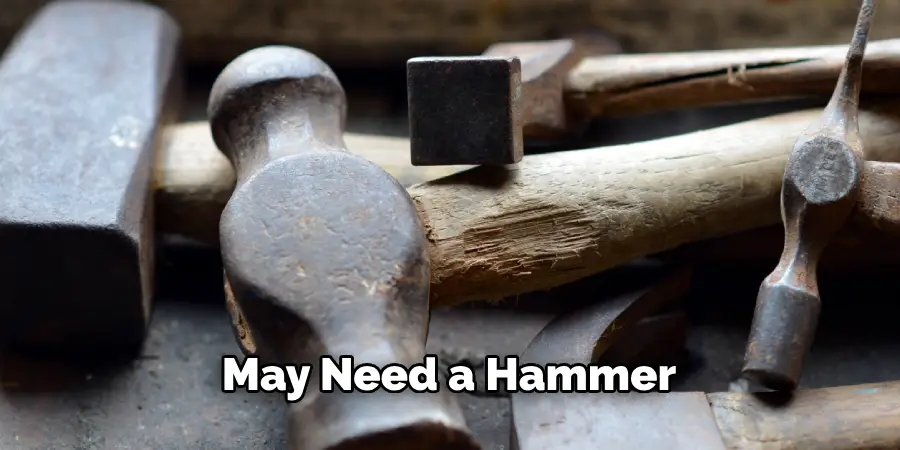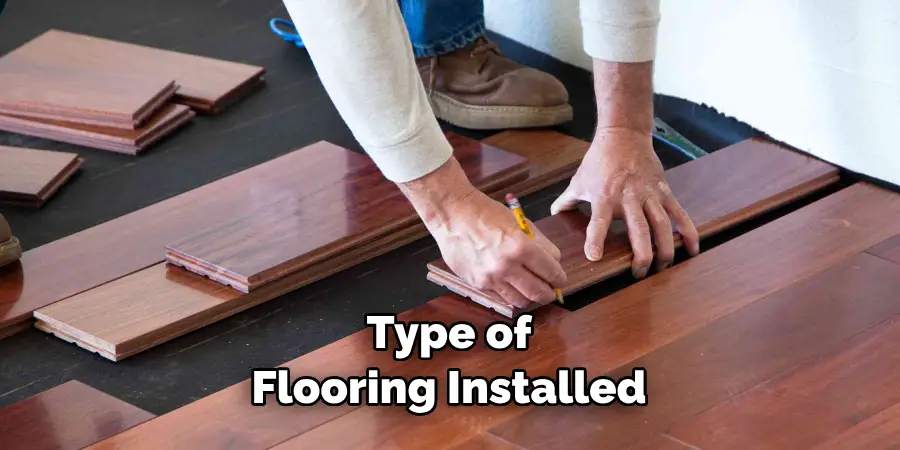Are you feeling inspired to transform your concrete floors from drab to fab? Laying flooring on top of concrete can give a room an instant transformation. Whether you’re laying laminate, hardwood, or other materials, the process of laying flooring on concrete is relatively straightforward and manageable for DIYers with some patience and practice.

In this blog post, we’ll cover everything you need to know about how to lay flooring on concrete and explore different types of materials to detailed installation tips — so that you can lay a beautiful new floor with confidence. So if you’re ready to get started creating a stunning new look in your home, let’s dive right in!
Tools and Materials You Will Need to Lay Flooring on Concrete
- Underlayment
- Laminate, hardwood flooring, or other material of your choice
- Tape measure and chalk line
- Hammer or rubber mallet
- Utility knife
- Hand saw or power saw with a masonry blade
- Safety glasses and work gloves
- Nails, screws, or adhesive
Step-by-Step Guidelines on How to Lay Flooring on Concrete
Step 1: Prepare the Concrete Surface
Before you can start laying your flooring, you need to make sure that the concrete surface is level and free from debris. If necessary, use a self-leveler compound to even out any dips or bumps on the surface. You should also use a damp cloth to remove any dirt or debris that may be present. Preparing the concrete surface is a crucial step for achieving a successful installation.

Step 2: Install Underlayment
Underlayment will provide a smooth and even surface for your flooring to rest on, as well as protect it from moisture damage. It’s important that you follow the manufacturer’s instructions when installing the underlayment. Installing the underlayment also requires fastening it in place with nails or adhesive. This is also the time to install any soundproofing or vapor barrier materials if needed.
Step 3: Measure and Cut Flooring Pieces
Measure the length and width of your room to determine how much flooring material you need. Once you have all the necessary measurements, it’s time to start cutting the pieces of flooring according to your desired shape or pattern. For this, you will need a hand saw or power saw with a masonry blade. Carefully measure and mark the pieces of flooring before cutting, to avoid any mistakes.
Step 4: Lay the Flooring
Now that all the pieces of flooring have been cut to size it’s time to start laying them on the prepared surface. Be sure to lay the boards in straight rows and use spacers between each piece for even spacing. You can use a hammer or rubber mallet to tap the boards into place. You may also need to fasten each board with nails, screws, or adhesive depending on your flooring material and manufacturer’s instructions.
Step 5: Sealing and Finishing
Once you have finished laying your floor, let it sit for at least 24 hours before sealing it. This will allow the flooring to acclimate to the room’s temperature and humidity. Once it’s dried, you can apply a sealant or finish according to the manufacturer’s instructions. This will help protect your newly installed floor from everyday wear and tear.
That concludes our guide on how to lay flooring on concrete! Following these steps should help you create a beautiful, long-lasting floor that you can enjoy for years to come. With the right materials and tools, laying a new floor on concrete is an achievable project for any DIY enthusiast.
Additional Tips and Tricks to Lay Flooring on Concrete

- Before installing the flooring, make sure the concrete surface is clean and dry. Use a broom to sweep away any dust or debris, then vacuum up dirt particles with a shop vac. Allow the area to dry completely before continuing.
- Measure the space two times and cut accordingly, so that your flooring pieces fit together perfectly. If you are using a circular saw or table saw, be sure to wear safety goggles and gloves.
- To prevent the flooring from shifting while you work on it, use double-sided carpet tape around the perimeter of the room and over seams between planks. This will keep each piece firmly in place until you are done laying them all down.
- When laying your planks, it’s important to stagger the seams between each plank. This will help prevent any gaps or weak spots from forming in the flooring later on.
- To make sure that all pieces fit together snugly, use a rubber mallet to tap them into place. The mallet is also helpful for pushing down any raised edges that may occur during installation.
- To finish the job, apply a sealant or top coat over the flooring to help protect it from water damage and wear and tear. This will also give the surface a polished look and provide an extra layer of protection against dirt and grime.
With these tips in mind, you’ll be able to lay flooring on concrete with ease. With careful measuring, cutting, and installation, you can easily add a beautiful new floor to your home or business!
Precautions Need to Follow for Laying Flooring on Concrete
- Make sure the surface of the concrete is clean and dry before beginning to lay the flooring. Remove any dirt, debris, or moisture that may be on the surface of the concrete.
- Check for dips in your concrete subfloor; if there are any more than a quarter inch deep, take steps to level them out using self-leveling concrete.
- Check the concrete for cracks or other damage; repair any damage with a suitable patching material before laying the flooring.
- Inspect the surrounding walls and baseboards, and fill in any gaps or holes as needed so that they are flush with the floor when it is laid down. If necessary, use shims to make sure that the wall and baseboard are not flexing.
- Before laying down any flooring, make sure to spread out a vapor barrier underneath it first to act as insulation from moisture in the concrete substrate.
- When laying down your floor, stagger the end joints of each course for better stability. Make sure that you use a construction adhesive between each end joint and the subfloor to ensure that it is securely fixed in place.
- When using an adhesive, make sure to read and follow all of the manufacturer’s instructions for mixing, handling, and application.
- Before walking on the newly-laid flooring, allow adequate time for the adhesive to dry and cure properly; most adhesives require 24-48 hours for proper curing.
Following these precautions will ensure that your flooring is securely and properly laid on a concrete subfloor. In addition, by taking the time to go through these steps prior to installation you can help avoid costly repairs or replacements down the road.
Frequently Asked Questions
How Long Does It Take to Install Flooring on Concrete?
The amount of time needed for installation will vary depending on the type and size of the space, as well as the complexity of the project. Generally, it takes 1-3 days to lay flooring in a standard-size room (20 x 20 feet).
Do I Need Special Tools or Supplies to Lay Flooring on Concrete?
Yes. The tools and supplies needed for flooring installation on concrete depend on the type of flooring used. You may need a hammer, chisel, trowel, level, adhesive, seam tape, and/or jigsaw. Additionally, depending on the flooring material, you may also need underlayment and/or padding.

Is Laying Flooring on Concrete Hard?
It is generally not difficult to lay flooring on concrete, but it can be challenging depending on the size of the space and the complexity of the project. Specialized tools and supplies may be necessary for certain types of flooring such as tiles or luxury vinyl plank (LVP). Additionally, the concrete substrate should be properly prepared prior to installation.
Are There Any Special Considerations When Laying Flooring on Concrete?
Yes. It is important to ensure that the concrete surface is level and free from defects or blemishes prior to installation. Additionally, certain types of flooring may require the use of underlayment or padding to provide additional cushioning and insulation. Finally, it is important to follow the manufacturer’s instructions for the type of floor being installed.
Are There Any Maintenance Tips After Installing Flooring on Concrete?
Yes. Once the flooring is installed, it is important to maintain it properly in order to ensure its longevity. Regular vacuuming and sweeping will help keep dirt and debris from accumulating beneath the floor. Additionally, any spills should be cleaned up immediately to prevent staining or damage. For specific maintenance recommendations, consult the manufacturer’s instructions for the type of flooring installed.

What Are the Benefits of Laying Flooring on Concrete?
Laying flooring on concrete offers several benefits, including increased durability and soundproofing. Additionally, flooring installation on concrete can help to regulate indoor temperatures by providing an additional layer of insulation between your feet and the cold concrete below. Finally, laying flooring on concrete is often a cost-effective solution that can improve the aesthetics of any room.
Conclusion
The above information should provide an overview of how to lay flooring on concrete, as well as commonly asked questions about the process. It is important to always follow the manufacturer’s instructions and use the appropriate tools and supplies for your specific project.
Additionally, regular maintenance can help ensure that your floor lasts for many years. With proper preparation and care, you can successfully lay flooring on concrete and enjoy its beauty for years to come.
